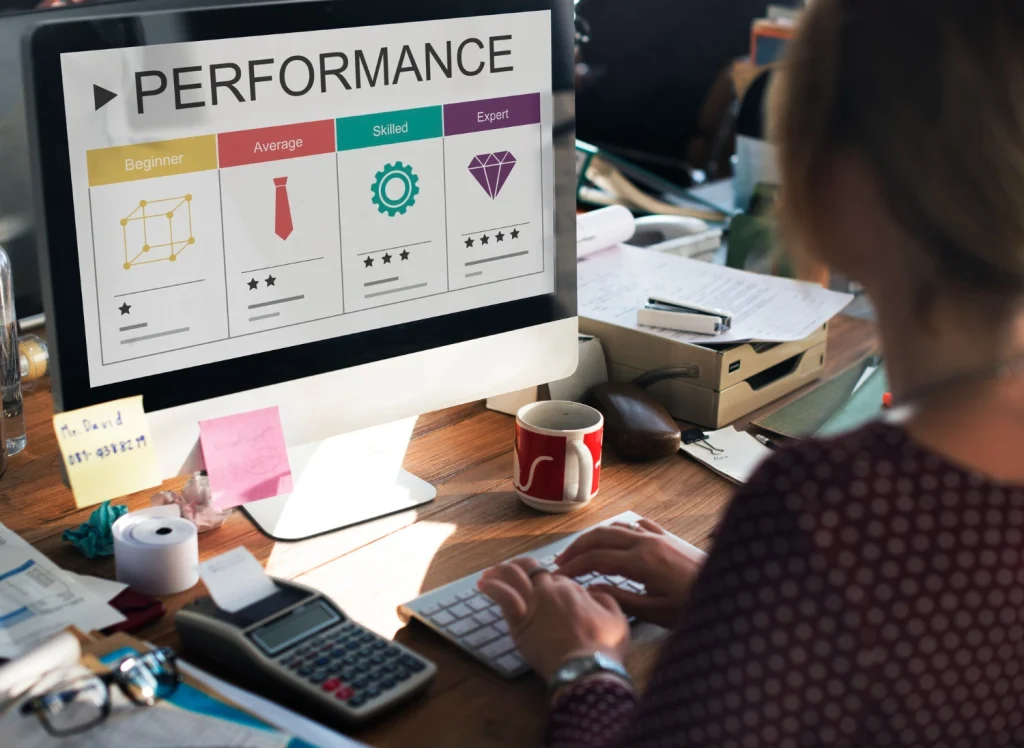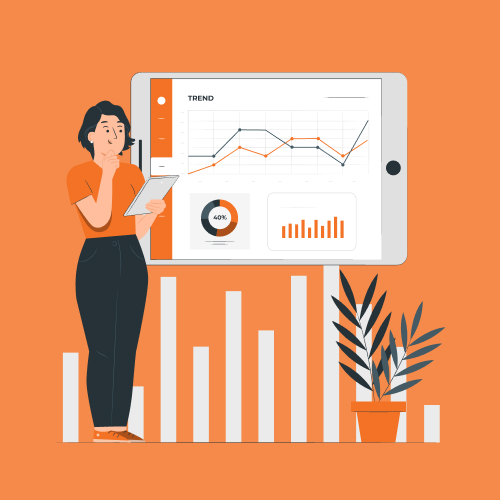Performance appraisal software centralises and automates employee evaluations, transforming how HR teams manage performance cycles.
By adopting performance management software, organisations shift away from cumbersome paper-based annual reviews toward continuous, real-time performance management. This approach keeps goals aligned with evolving business objectives, drives higher engagement, and reduces administrative overhead.
Data-driven insights power modern performance review software. Metrics such as competency ratings, goal progress, and peer feedback are captured automatically, offering objective measures that inform promotions, compensation, and development plans. HR professionals can use customisable dashboards to identify trends and intervene proactively.
MiHCM’s performance management module addresses these needs by combining appraisal automation, continuous feedback loops, and advanced analytics.
Leveraging MiHCM Lite, MiHCM Enterprise, and the MiHCM Data & AI suite, organisations unlock employee potential, predict workforce performance, and streamline evaluation workflows. With employee self-service portals and SmartAssist for AI-driven recommendations, HR teams deliver transparent, fair, and data-driven performance management at scale.
What is performance appraisal software?

Traditional vs Software-Based Appraisals
| Aspect | Traditional Appraisals | Software-Based Appraisals |
|---|---|---|
| Frequency | Annual or biannual | Continuous with real-time checkpoints |
| Data Collection | Manual forms, limited metrics | Automated capture from multiple sources |
| Feedback | Top-down only | Multi-directional: manager, peer, self |
| Reporting | Static PDF reports | Dynamic dashboards and analytics |
Performance appraisal software automates goal setting, feedback collection, and evaluation workflows. Traditional methods often rely on spreadsheets and paper forms, causing version control issues and delays. Software-based approaches ensure standardised evaluation templates, automated reminders, and secure storage of appraisal data.
Core components include goal management for aligning individual objectives with corporate strategy, a feedback engine for capturing ongoing check-ins, and customisable workflows that guide evaluations from self-review to final sign-off.
Integration with HRIS, payroll, and talent management systems ensures a seamless flow of information—eliminating duplicate data entry and maintaining cohesion across recruitment, learning, and compensation processes.
Key features to look for in performance management software
- Automated appraisal workflows: Customisable evaluation templates automate reminders, review stages, and approval chains. (Enhanced Performance Management)
- Continuous feedback tools: Real-time surveys, 1:1 check-ins, and peer reviews ensure timely performance touchpoints. (Employee Self-Service)
- Goal and competency tracking: Align individual goals with corporate objectives, measuring progress against defined competencies.
- AI-driven performance analytics: Predict workforce performance, identify skill gaps, and recommend development plans. (Performance Analysis)
- Employee self-service portals: Empower employees to view progress, request feedback, and update goals independently. (Enhanced Employee Engagement)
By selecting performance appraisal software with these capabilities, HR teams streamline appraisal processes, reducing administrative burden and ensuring consistency across departments. Automated workflows eliminate manual follow-ups, while continuous feedback tools foster a culture of transparency and growth.
Actionable insights powered by predictive analytics highlight high-potential talent and flag at-risk employees before turnover occurs. Employees gain ownership of their development through self-service features, boosting engagement and accountability. These core features make performance management software a strategic asset for mid to large enterprises.
Top benefits of using performance review software

- Improved employee engagement: Regular, structured feedback increases motivation and alignment.
- Greater transparency and fairness: Standardised criteria and anonymised peer reviews reduce bias.
- Data-driven decision-making: Comprehensive performance reports inform promotions, compensation, and training investments.
- Reduced bias: Objective metrics and calibrated rating scales enhance consistency.
- Talent identification: Spot high-potential employees and address skill gaps proactively using predictive insights.
Incorporating performance appraisal software helps organisations transition from subjective assessments to evidence-based evaluations. HR teams leverage workforce analytics to inform talent reviews and succession planning. Managers spend less time on administrative tasks and more time coaching employees.
The result is a positive feedback loop where transparent evaluations and actionable development plans drive continuous performance improvement.
Leveraging employee performance analytics
Employee performance analytics consolidates key metrics—productivity rates, competency scores, and engagement indexes—into unified dashboards. Segmentation and pattern grouping reveal trends across teams, business units, and demographics, enabling HR to identify at-risk employees before turnover spikes.
Predictive analytics forecast performance trajectories based on historical data, highlighting individuals who may benefit from targeted learning interventions or manager coaching. Visualisation dashboards provide real-time monitoring of team health, goal attainment, and feedback frequency.
MiHCM Data & AI and SmartAssist power advanced analytics capabilities. SmartAssist uses machine learning to suggest personalised development resources and automated feedback prompts. The MiHCM Data & AI engine aggregates performance data across applications—HRIS, learning management, and payroll—to deliver holistic insights that drive proactive talent management strategies.
How to choose the best performance appraisal software
Selection criteria checklist:
- Assess current workflows: Map existing appraisal processes and identify pain points.
- Evaluate feature fit: Confirm availability of automation, continuous feedback loops, analytics, and HRIS integrations.
- Consider scalability: Ensure performance management software can grow with your headcount and geographic footprint.
- Review usability: Check UI/UX, mobile accessibility, and employee adoption factors.
- Verify security and compliance: Confirm data encryption, role-based access, and adherence to data protection standards.
- Compare pricing: Analyse subscription tiers, implementation fees, and total cost of ownership over time.
A thorough evaluation ensures the right balance between functionality, user experience, and budget. Engage stakeholders across HR, IT, and finance during vendor demos. Pilot programs can validate adoption and ROI before enterprise-wide deployment.
Implementing your performance management software

Begin with a pilot program involving a representative group of managers and employees. Offer role-based training sessions and clear documentation to drive user adoption. Use change management tactics—town halls, internal champions, and feedback surveys—to build buy-in.
Define success metrics such as review completion rates, feedback frequency, and employee satisfaction scores. Monitor these KPIs through the software’s analytics dashboards to gauge ROI and identify areas for improvement.
Iterate on appraisal cycles by adjusting templates, feedback cadence, and rating scales based on user feedback. For comprehensive integration, explore MiHCM’s HR ecosystem: combine MiHCM Lite or MiHCM Enterprise with MiHCM Data & AI and SmartAssist for a fully unified performance management solution.



